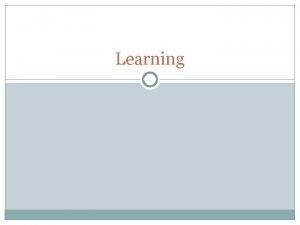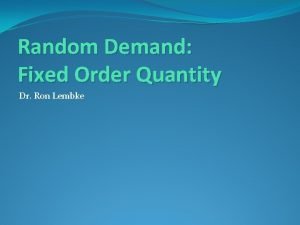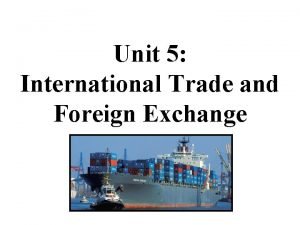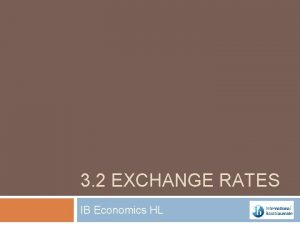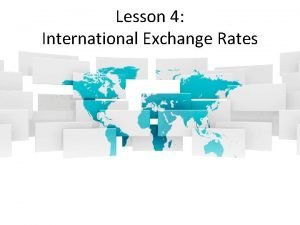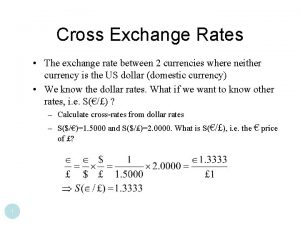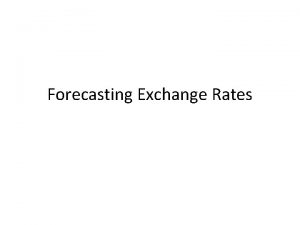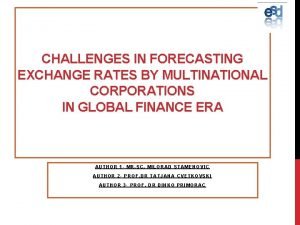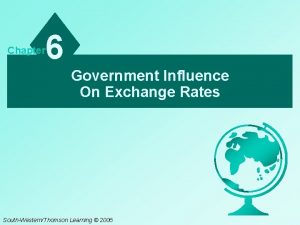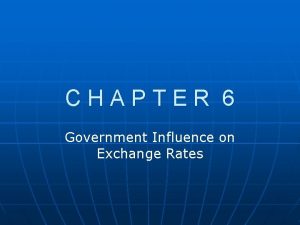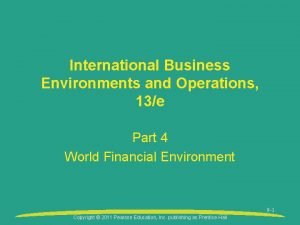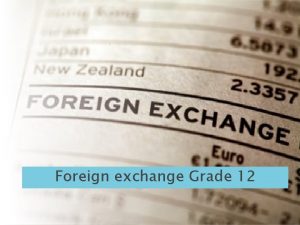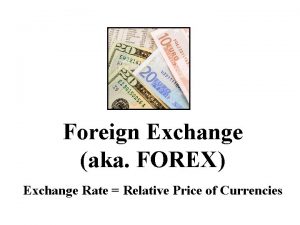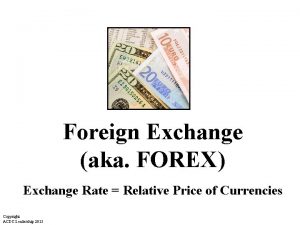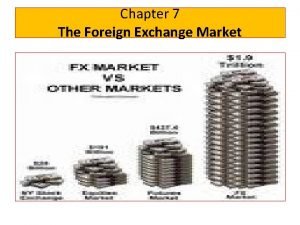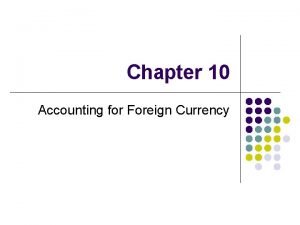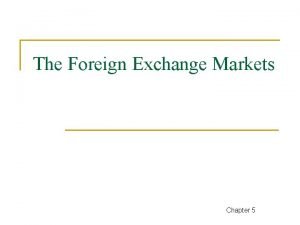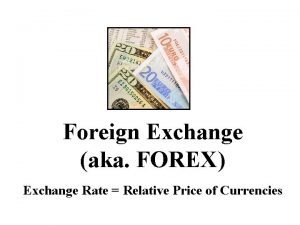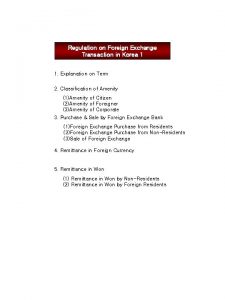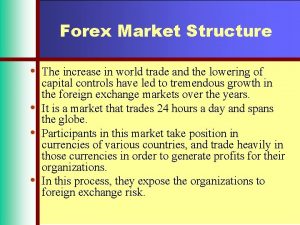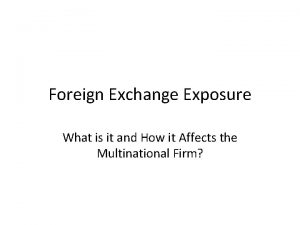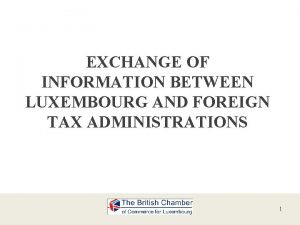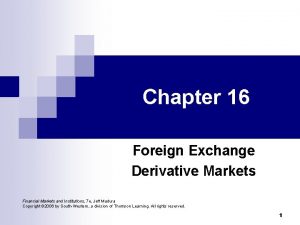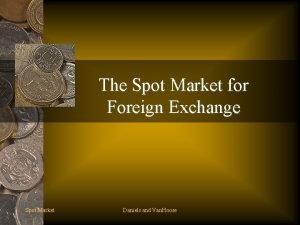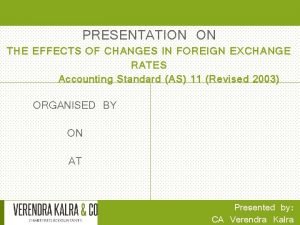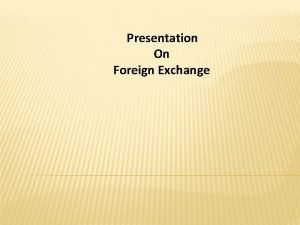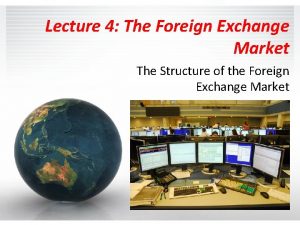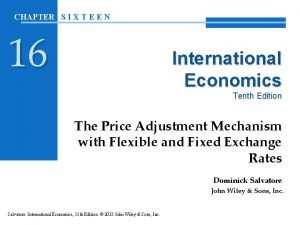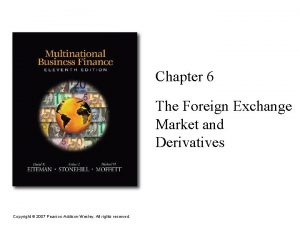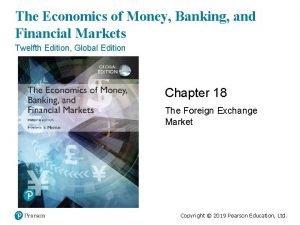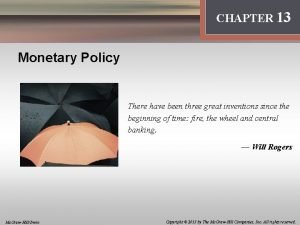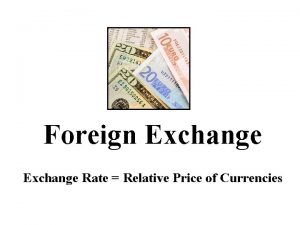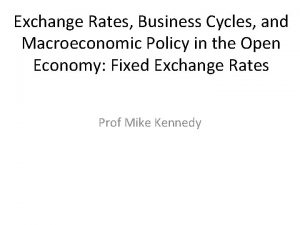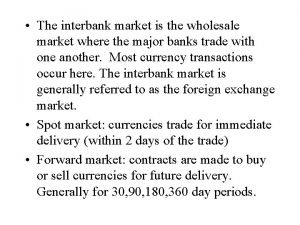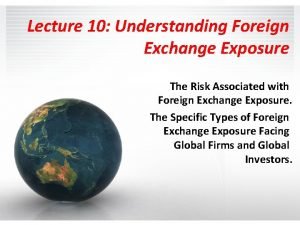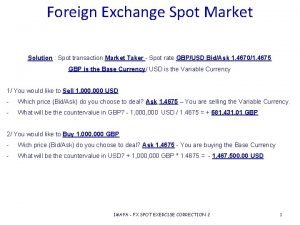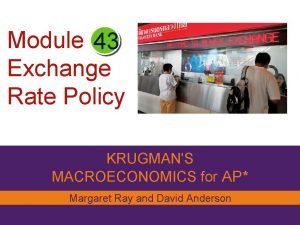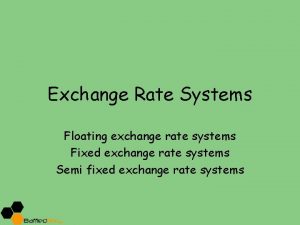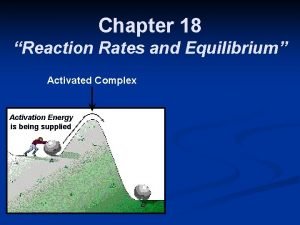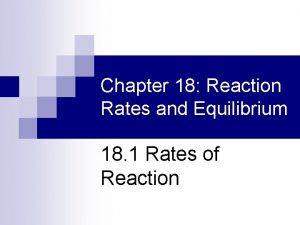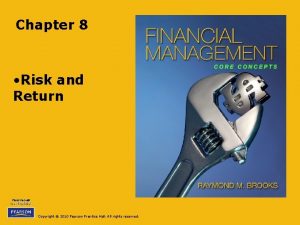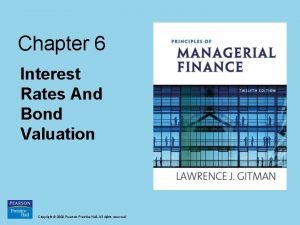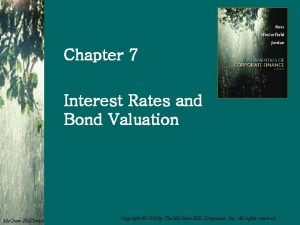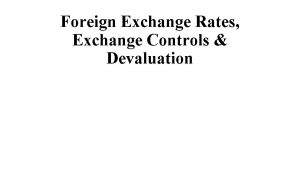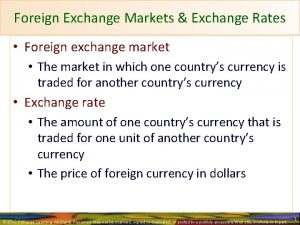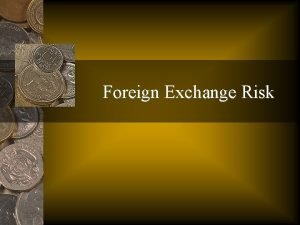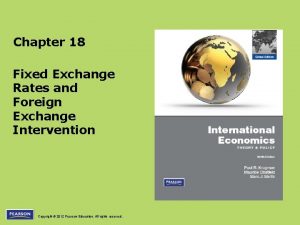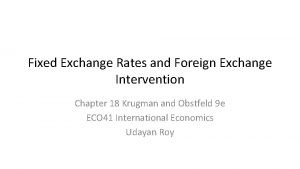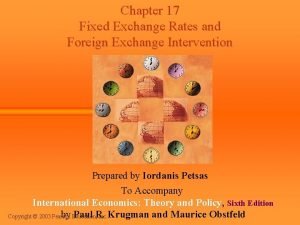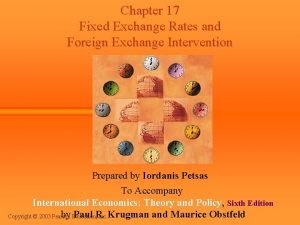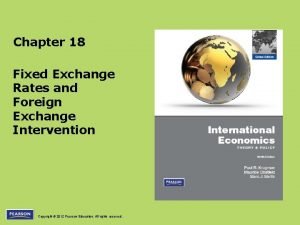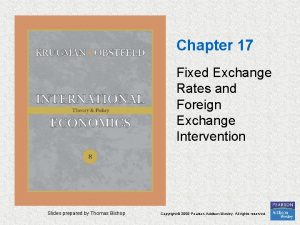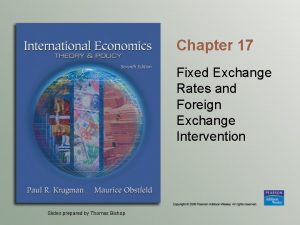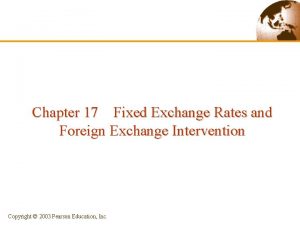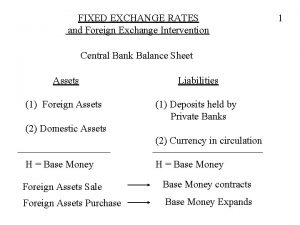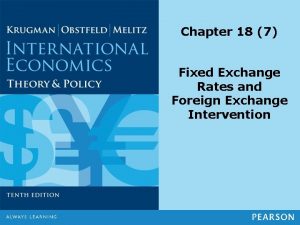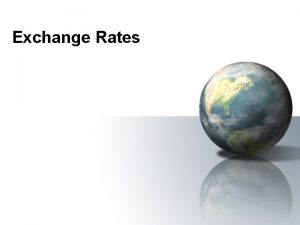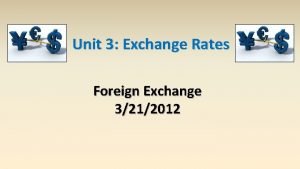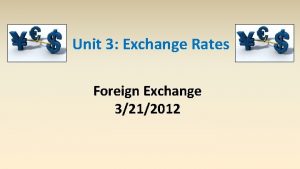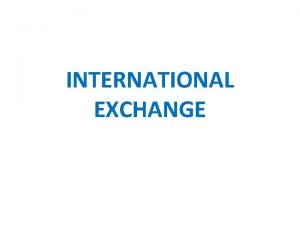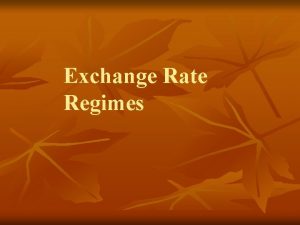Chapter 17 Fixed Exchange Rates and Foreign Exchange





































































- Slides: 69

Chapter 17 Fixed Exchange Rates and Foreign Exchange Intervention Slides prepared by Thomas Bishop

Preview • Balance sheets of central banks • Intervention in the foreign exchange market and the money supply • How the central bank fixes the exchange rate • Monetary and fiscal policies under fixed exchange rates • Financial market crises and capital flight • Types of fixed exchange rates: reserve currency and gold standard systems • Zero interest rates, deflation and liquidity traps Copyright © 2006 Pearson Addison-Wesley. All rights reserved. 2

Introduction • Many countries try to fix or “peg” their exchange rate to a currency or group of currencies by intervening in the foreign exchange market. • Many with a flexible or “floating” exchange rate in fact practice a managed floating exchange rate. ¨ The central bank “manages” the exchange rate from time to time by buying and selling currency and assets, especially in periods of exchange rate volatility. • How do central banks intervene in the foreign exchange market? Copyright © 2006 Pearson Addison-Wesley. All rights reserved. 3

Central Bank Intervention and the Money Supply • To study the effects of central bank intervention in the foreign exchange market, first construct a simplified balance sheet for the central bank. ¨ This records the assets and liabilities of a central bank. ¨ Balance sheets use double booking keeping: each transaction enters the balance sheet twice. Copyright © 2006 Pearson Addison-Wesley. All rights reserved. 4

Central Bank’s Balance Sheet • Assets ¨ Foreign government bonds (official international reserves) ¨ Gold (official international reserves) ¨ Domestic government bonds ¨ Loans to domestic banks (called discount loans in US) • Liabilities ¨ Deposits of domestic banks ¨ Currency in circulation (previously central banks had to give up gold when citizens brought currency) Copyright © 2006 Pearson Addison-Wesley. All rights reserved. 5

Central Bank’s Balance Sheet (cont. ) • Assets = Liabilities + Net worth ¨ If we assume that net worth of the central bank always equals zero then assets = liabilities. ¨ An increase in assets leads to an equal increase in liabilities. ¨ A decrease in assets leads to an equal decrease in liabilities. • Changes in the central bank’s balance sheet lead to changes in currency in circulation or changes in bank deposits, which lead to changes in the money supply. ¨ If their deposits at the central bank increase, banks typically have more funds available to lend to customers, so that the amount of money in circulation increases. Copyright © 2006 Pearson Addison-Wesley. All rights reserved. 6

Assets, Liabilities and the Money Supply • A purchase of any asset will be paid for with currency or a check from the central bank, both of which are denominated in domestic currency, and ¨ both of which increase the supply of money in circulation. ¨ The transaction leads to equal increases of assets and liabilities. ¨ • When the central bank buys domestic bonds or foreign bonds, the domestic money supply increases. Copyright © 2006 Pearson Addison-Wesley. All rights reserved. 7

Assets, Liabilities and the Money Supply (cont. ) • A sale of any asset will be paid for with currency or a check given to the central bank, ¨ both of which are denominated in domestic currency. ¨ The central bank puts the currency into its vault or reduces the amount of bank deposits, ¨ causing the supply of money in circulation to shrink. ¨ The transaction leads to equal decreases of assets and liabilities. • When the central bank sells domestic bonds or foreign bonds, the domestic money supply decreases. Copyright © 2006 Pearson Addison-Wesley. All rights reserved. 8

Foreign Exchange Markets • Central banks trade foreign government bonds in the foreign exchange markets. ¨ Foreign currency deposits and foreign government bonds are often substitutes: both are fairly liquid assets denominated in foreign currency. ¨ Quantities of both foreign currency deposits and foreign government bonds that are bought and sold influence the exchange rate. Copyright © 2006 Pearson Addison-Wesley. All rights reserved. 9

Sterilization • Because buying and selling of foreign bonds in the foreign exchange market affects the domestic money supply, a central bank may want to offset this effect. • This offsetting effect is called sterilization. • If the central bank sells foreign bonds in the foreign exchange market, it can buy domestic government bonds in bond markets —hoping to leave the amount of money in circulation unchanged. Copyright © 2006 Pearson Addison-Wesley. All rights reserved. 10

Fixed Exchange Rates • To fix the exchange rate, a central bank influences the quantities supplied and demanded of currency by trading domestic and foreign assets, so that the exchange rate (the price of foreign currency in terms of domestic currency) stays constant. • The foreign exchange market is in equilibrium when R = R* + (Ee – E)/E • When the exchange rate is fixed at some level E 0 and the market expects it to stay fixed at that level, then R = R* Copyright © 2006 Pearson Addison-Wesley. All rights reserved. 11

Fixed Exchange Rates (cont. ) • To fix the exchange rate, the central bank must trade foreign and domestic assets until R = R*. • In other words, it adjusts the money supply until the domestic interest rate equals the foreign interest rate, given the price level and real output, until: Ms/P = L(R*, Y) Copyright © 2006 Pearson Addison-Wesley. All rights reserved. 12

Fixed Exchange Rates (cont. ) • Suppose that the central bank has fixed the exchange rate at E 0 but the level of output rises, raising the demand for real money. • This leads to higher interest rates and upward pressure on the value of the domestic currency. • How should the central bank respond if it wants to fix exchange rates? Copyright © 2006 Pearson Addison-Wesley. All rights reserved. 13

Fixed Exchange Rates (cont. ) • The central bank must buy foreign assets in the foreign exchange market, ¨ thereby increasing the money supply, ¨ thereby reducing interest rates. ¨ Alternatively, by demanding (buying) assets denominated in foreign currency and by supplying (selling) domestic currency, the price/value of foreign currency is increased and the price/value of domestic currency is decreased. Copyright © 2006 Pearson Addison-Wesley. All rights reserved. 14

Fixed Exchange Rates Copyright © 2006 Pearson Addison-Wesley. All rights reserved. 15

Monetary Policy and Fixed Exchange Rates • Because the central bank must buy and sell foreign assets to keep the exchange rate fixed, monetary policy is ineffective in influencing output and employment. Copyright © 2006 Pearson Addison-Wesley. All rights reserved. 16

Monetary Policy and Fixed Exchange Rates (cont. ) Copyright © 2006 Pearson Addison-Wesley. All rights reserved. 17

Fiscal Policy and Fixed Exchange Rates in the Short Run • Because the central bank must buy and sell foreign assets to keep the exchange rate fixed, temporary fiscal policy is more effective in influencing output and employment in the short run. ¨ The rise in output due to expansionary fiscal policy raises money demand, putting upward pressure on interest rates and upward pressure on the value of the domestic currency. ¨ To prevent an appreciation of the domestic currency, the central bank must buy foreign assets, thereby increasing the money supply. Copyright © 2006 Pearson Addison-Wesley. All rights reserved. 18

Fiscal Policy and Fixed Exchange Rates in the Short Run (cont. ) A fiscal expansion increases aggregate demand To prevent the domestic currency from appreciating, the central bank buys foreign assets, increasing the money supply and decreasing interest rates. Copyright © 2006 Pearson Addison-Wesley. All rights reserved. 19

Fiscal Policy and Fixed Exchange Rates in the Long Run • When the exchange rate is fixed, there is no real appreciation of the value of domestic products in the short run. • But when output is above its normal (long run) level, wages and prices tend to rise. • A rising price level makes domestic products more expensive: a real appreciation (EP*/P falls). ¨ Aggregate demand output decrease as prices rise: DD curve shifts left. ¨ Prices tend to rise until employment, aggregate demand output fall to their normal levels. Copyright © 2006 Pearson Addison-Wesley. All rights reserved. 20

Fiscal Policy and Fixed Exchange Rates in the Long Run (cont. ) • In the long run prices increase proportionally to the increase in the money supply caused by central bank intervention in the foreign exchange market. ¨ AA curve shifts down (left) as prices rise. ¨ Nominal exchange rates will be constant (as long as the fixed exchange rate is maintained), but the real exchange rate will be lower (a real appreciation). Copyright © 2006 Pearson Addison-Wesley. All rights reserved. 21

Devaluation and Revaluation • Depreciation and appreciation refer to changes in the value of a currency due to market changes. • Devaluation refers to a change in a fixed exchange rate caused by the central bank. ¨ a unit of domestic currency is made less valuable, so that more units must be exchanged for 1 unit of foreign currency. • Revaluation is also a change in a fixed exchange rate caused by the central bank. ¨ a unit of domestic currency is made more valuable, so that fewer units need to be exchanged for 1 unit of foreign currency. Copyright © 2006 Pearson Addison-Wesley. All rights reserved. 22

Devaluation • For devaluation to occur, the central bank buys foreign assets, so that the domestic money supply increases, and interest rates fall, causing a fall in the return on domestic currency assets. ¨ Domestic goods are cheaper, so aggregate demand output increase. ¨ Official international reserve assets (foreign bonds) increase. Copyright © 2006 Pearson Addison-Wesley. All rights reserved. 23

Devaluation (cont. ) If the central bank devalues the domestic currency so that the new fixed exchange rate is E 1, it buys foreign assets, increasing the money supply, decreasing the interest rate and increasing output Copyright © 2006 Pearson Addison-Wesley. All rights reserved. 24

Financial Crises and Capital Flight • When a central bank does not have enough official international reserve assets to maintain a fixed exchange rate, a balance of payments crisis results. ¨ To sustain a fixed exchange rate, the central bank must have enough foreign assets to sell in order to satisfy the demand for them at the fixed exchange rate. Copyright © 2006 Pearson Addison-Wesley. All rights reserved. 25

Financial Crises and Capital Flight (cont. ) • Investors may expect that the domestic currency will be devalued, causing them to want foreign assets instead of domestic assets, whose value is expected to fall soon. 1. This expectation or fear only makes the balance of payments crisis worse: ¨ investors rush to change their domestic assets into foreign assets, depleting the stock of official international reserve assets more quickly. Copyright © 2006 Pearson Addison-Wesley. All rights reserved. 26

Financial Crises and Capital Flight (cont. ) 2. As a result, financial capital is quickly moved from domestic assets to foreign assets: capital flight. ¨ The domestic economy has a shortage of financial capital for investment and has low aggregate demand. 3. To avoid this outcome, domestic assets must offer a high interest rates to entice investors to hold them. ¨ The central bank can push interest rates higher by reducing the money supply (by selling foreign assets). 4. As a result, the domestic economy may face high interest rates, reduced money supply, low aggregate demand, low output and low employment. Copyright © 2006 Pearson Addison-Wesley. All rights reserved. 27

Financial Crises and Capital Flight (cont. ) Expected devaluation makes the expected return on foreign assets higher To attract investors to hold domestic assets (currency) at the original exchange rate, the interest rate must rise through a sale of foreign assets. Copyright © 2006 Pearson Addison-Wesley. All rights reserved. 28

Financial Crises and Capital Flight (cont. ) • Expectations of a balance of payments crisis only worsen the crisis and hasten devaluation. What causes expectations to change? ¨ Expectations about the central bank’s ability and willingness to maintain the fixed exchange rate. ¨ Expectations about the economy: shrinking demand for domestic products relative to foreign products means that the domestic currency should become less valuable. ¨ • In fact, expectations of devaluation cause a devaluation: self-fulfilling crisis. Copyright © 2006 Pearson Addison-Wesley. All rights reserved. 29

Financial Crises and Capital Flight (cont. ) • What happens if the central bank runs out of official international reserves (foreign assets)? • It must devalue the domestic currency so that it takes more domestic currency (assets) to exchange for 1 unit of foreign currency (asset). ¨ This will allow the central bank to replenish its foreign assets by buying them back at a devalued rate, ¨ increasing the money supply, ¨ reducing interest rates, ¨ reducing the value of domestic products, ¨ increasing aggregate demand, output, employment over time. Copyright © 2006 Pearson Addison-Wesley. All rights reserved. 30

Financial Crises and Capital Flight (cont. ) • In a balance of payments crisis, ¨ the central bank may buy domestic bonds and sell domestic currency (to increase the money supply) to prevent high interest rates, but this only depreciates the domestic currency more. ¨ the central bank generally can not satisfy the goals of low interest rates and fixed exchange rates simultaneously. Copyright © 2006 Pearson Addison-Wesley. All rights reserved. 31

Interest Rate Differentials • For many countries, the expected rates of return are not the same: R > R*+(Ee –E)/E. Why? • Default risk: The risk that the country’s borrowers will default on their loan repayments. Lenders require a higher interest rate to compensate for this risk. • Exchange rate risk: If there is a risk that a country’s currency will depreciate or be devalued, then domestic borrowers must pay a higher interest rate to compensate foreign lenders. Copyright © 2006 Pearson Addison-Wesley. All rights reserved. 32

Interest Rate Differentials (cont. ) • Because of these risks, domestic assets and foreign assets are not treated the same. ¨ Previously, we assumed that foreign and domestic currency deposits were perfect substitutes: deposits everywhere were treated as the same type of investment, because risk and liquidity of the assets were assumed to be the same. ¨ In general, foreign and domestic assets may differ in the amount of risk that they carry: they may be imperfect substitutes. ¨ Investors consider this risk, as well as rates of return on the assets, when deciding whether to invest. Copyright © 2006 Pearson Addison-Wesley. All rights reserved. 33

Interest Rate Differentials (cont. ) • A difference in the risk of domestic and foreign assets is one reason why expected returns are not equal across countries: R = R*+(Ee –E)/E + where is called a risk premium, an additional amount needed to compensate investors for investing in risky domestic assets. • The risk could be caused by default risk or exchange rate risk. Copyright © 2006 Pearson Addison-Wesley. All rights reserved. 34

Interest Rate Differentials (cont. ) Increase in the perceived risk of investing in domestic assets makes foreign assets more attractive and leads to a depreciation of the domestic currency. Or at fixed exchange rates, the return on domestic assets needs to be higher in equilibrium

CASE STUDY: The Mexican Peso Crisis, 1994– 1995 • In late 1994, the Mexican central bank devalued the value of the peso relative to the US dollar. • This action was accompanied by high interest rates, capital flight, low investment, low production and high unemployment. • What happened? Copyright © 2006 Pearson Addison-Wesley. All rights reserved. 36

CASE STUDY: The Mexican Peso Crisis, 1994– 1995 (cont. ) Source: Saint Louis Federal Reserve Copyright © 2006 Pearson Addison-Wesley. All rights reserved. 37

Understanding the Crisis • In the early 1990 s, Mexico was an attractive place foreign investment, especially from NAFTA partners. • During 1994, political developments caused an increase in Mexico’s risk premium ( ) due to increases in default risk and exchange rate risk: ¨ peasant uprising in Chiapas ¨ assassination of leading presidential candidate from PRI • Also, the Federal Reserve raised US interest rates during 1994 to prevent US inflation. (So, R* ! ) Copyright © 2006 Pearson Addison-Wesley. All rights reserved. 38

Understanding the Crisis (cont. ) • These events put downward pressure on the value of the peso. • Mexico’s central bank had promised to maintain the fixed exchange rate. • To do so, it sold dollar denominated assets, decreasing the money supply and increasing interest rates. • To do so, it needed to have adequate reserves of dollar denominated assets. Did it? Copyright © 2006 Pearson Addison-Wesley. All rights reserved. 39

US Dollar Denominated International Reserves of the Mexican Central Bank January 1994 ……………… $27 billion October 1994 …………………$17 billion November 1994 ………. . …… $13 billion December 1994 ………. . …… $ 6 billion During 1994, Mexico’s central bank hid the fact that its reserves were being depleted. Why? Source: Banco de México, http: //www. banxico. org. mx Copyright © 2006 Pearson Addison-Wesley. All rights reserved. 40

Understanding the Crisis • 20 Dec 1994: Mexico devalues the peso by 13%. It fixes E at 4. 0 pesos/dollar instead of 3. 4 pesos/dollar. • Investors expect that the central bank has depleted its reserves. • ! further due to exchange rate risk: investors expect that the central bank to devalue again and they sell Mexican assets, putting more downward pressure on the value of the peso. • 22 Dec 1994: with reserves nearly gone, the central bank abandons the fixed rate. • In a week, the peso falls another 30% to about 5. 7 pesos/dollar. Copyright © 2006 Pearson Addison-Wesley. All rights reserved. 41

The Rescue Package: Reducing • The US & IMF set up a $50 billion fund to guarantee the value of loans made to Mexico’s government, ¨ reducing default risk, ¨ and reducing exchange rate risk, since foreign loans could act as official international reserves to stabilize the exchange rate if necessary. • After a recession in 1995, Mexico began a recovery from the crisis. ¨ Mexican goods were relatively cheap. ¨ Stronger demand for Mexican products reduced negative effects of exchange rate risk. Copyright © 2006 Pearson Addison-Wesley. All rights reserved. 42

Types of Fixed Exchange Rate Systems 1. Reserve currency system: one currency acts as official international reserves. ¨ The US dollar was the currency that acted as official international reserves from under the fixed exchange rate system from 1944– 1973. ¨ All countries but the US held US dollars as the means to make official international payments. 2. Gold standard: gold acts as official international reserves that all countries use to make official international payments. Copyright © 2006 Pearson Addison-Wesley. All rights reserved. 43

Reserve Currency System • From 1944– 1973, each central bank fixed the value of its currency relative to the US dollar by buying or selling domestic assets in exchange for dollar assets. • Arbitrage ensured that exchange rates between any two currencies remained fixed. ¨ Suppose Bank of Japan fixed the exchange rate at 360¥/US$1 and the Bank of France fixed the exchange rate at 5 Ffr/US$1 ¨ The yen/franc rate would be 360¥/US$1 / 5 Ffr/US$1 = 72¥/1 Ffr ¨ If not, then currency traders could make an easy profit by buying currency where it is cheap and selling it where it is expensive. Copyright © 2006 Pearson Addison-Wesley. All rights reserved. 44

Reserve Currency System (cont. ) • Because most countries maintained fixed exchange rates by trading dollar denominated (foreign) assets, they had ineffective monetary policies. • The Federal Reserve, however, did not have to intervene in foreign exchange markets, so it could conduct monetary policy to influence aggregate demand, output and employment. ¨ The US was in a special position because it was able to use monetary policy as it wished. Copyright © 2006 Pearson Addison-Wesley. All rights reserved. 45

Reserve Currency System (cont. ) • In fact, the monetary policy of the US influenced the economies of other countries. • Suppose the US increased its money supply. ¨ This would lower US interest rates, putting downward pressure on the value of the US dollar. ¨ If other central banks maintained their fixed exchange rates, they would have needed to buy dollar denominated (foreign) assets, increasing their money supplies. ¨ In effect, the monetary policies of other countries had to follow that of the US, which was not always optimal for their levels of output and employment. Copyright © 2006 Pearson Addison-Wesley. All rights reserved. 46

Gold Standard • Under the gold standard from 1870– 1914 and after 1918 for some countries, each central bank fixed the value of its currency relative to a quantity of gold (in ounces or grams) by trading domestic assets in exchange for gold. ¨ For example, if the price of gold was fixed at $35 per ounce by the Federal Reserve while the price of gold was fixed at £ 14. 58 per ounce by the Bank of England, then the $/£ exchange rate must have been fixed at $2. 40 per pound. ¨ Why? Copyright © 2006 Pearson Addison-Wesley. All rights reserved. 47

Gold Standard (cont. ) • The gold standard did not give the monetary policy of the US or any other country a privileged role. • If one country lost official international reserves (gold) and thereby decreased its money supply, then another country gained them and thereby increased its money supply. • The gold standard also acted as an automatic restraint on increasing money supplies too quickly, preventing inflationary monetary policies. Copyright © 2006 Pearson Addison-Wesley. All rights reserved. 48

Gold Standard (cont. ) • But restraints on monetary policy restrained central banks from increasing the money supply to encourage aggregate demand, increasing output and employment. • And the price of gold relative to other goods and services varied, depending on the supply and demand of gold. ¨ A new supply of gold made gold abundant (cheap), and prices of other goods and services rose because the currency price of gold was fixed. ¨ Strong demand for gold jewelry made gold scarce (expensive), and prices of other goods and services fell because the currency price of gold was fixed. Copyright © 2006 Pearson Addison-Wesley. All rights reserved. 49

Gold Standard (cont. ) • A reinstated gold standard would require new discoveries of gold to increase the money supply as economies and populations grow. • A reinstated gold standard may give Russia, South Africa, the US or other gold producers inordinate influence in international financial and macroeconomic conditions. Copyright © 2006 Pearson Addison-Wesley. All rights reserved. 50

Gold Exchange Standard • The gold exchange standard: a system of official international reserves in both a group of currencies (with fixed prices of gold) and gold itself. ¨ allows more flexibility in the growth of international reserves, depending on macroeconomic conditions, because the amount of currencies held as reserves could change. ¨ does not constrain economies as much to the supply and demand of gold ¨ The fixed exchange rate system from 1944– 1973 used gold, and so operated more like a gold exchange standard than a currency reserve system. Copyright © 2006 Pearson Addison-Wesley. All rights reserved. 51

Gold and Silver Standard • Bimetallic standard: the value of currency is based on both silver and gold. • The US used a bimetallic standard from 1837– 1861. • Banks coined specified amounts of gold or silver into the national currency unit. ¨ 371. 25 grains of silver or 23. 22 grains of gold could be turned into a silver or a gold dollar. ¨ So gold was worth 371. 25/23. 22 = 16 times as much as silver. ¨ See http: //www. micheloud. com/FXM/MH/index. htm for a fun description of the bimetallic standard, the gold standard after 1873 (“Crime of 1873”) and the Wizard of Oz! Copyright © 2006 Pearson Addison-Wesley. All rights reserved. 52

Summary 1. Changes in a central bank’s balance sheet lead to changes in the domestic money supply. ¨ Buying domestic or foreign assets increases the domestic money supply. ¨ Selling domestic or foreign assets decreases the domestic money supply. 2. When markets expect exchange rates to be fixed, domestic and foreign assets have equal expected returns if they are treated as perfect substitutes. Copyright © 2006 Pearson Addison-Wesley. All rights reserved. 53

Summary (cont. ) 3. Monetary policy is ineffective in influencing output or employment under fixed exchange rates. 4. Temporary fiscal policy is more effective in influencing output and employment under fixed exchange rates, compared to under flexible exchange rates. Copyright © 2006 Pearson Addison-Wesley. All rights reserved. 54

Summary (cont. ) 5. A balance of payments crisis occurs when a central bank does not have enough official international reserves to maintain a fixed exchange rate. 6. Capital flight can occur if investors expect a devaluation, which may occur if they expect that a central bank can no longer maintain a fixed exchange rate: self-fulfilling crises can occur. 7. Domestic and foreign assets may not be perfect substitutes due to differences in default risk or due to exchange rate risk. Copyright © 2006 Pearson Addison-Wesley. All rights reserved. 55

Summary (cont. ) 8. Under a reserve currency system, all central banks but the one who controls the supply of the reserve currency trade the reserve currency to maintain fixed exchange rates. 9. Under a gold standard, all central banks trade gold to maintain fixed exchange rates. Copyright © 2006 Pearson Addison-Wesley. All rights reserved. 56

Interest Rates, Exchange Rates and a Liquidity Trap • A liquidity trap occurs when nominal interest rates fall to zero and the central bank cannot encourage people to hold more liquid assets (money). ¨ Nominal interest rates can not fall below zero: depositors would have to pay to put their money in banks. ¨ At a zero interest rate market equilibrium, people are indifferent between holding money and interest bearing assets, and the central bank can not encourage people to hold more money. Copyright © 2006 Pearson Addison-Wesley. All rights reserved. 57

A Liquidity Trap for Japan? Copyright © 2006 Pearson Addison-Wesley. All rights reserved. 58

Interest Rates, Exchange Rates and a Liquidity Trap • If interest rates are stuck at zero, then R = 0 = R* + (Ee – E)/E ¨ –ER*= Ee–E ¨ E(1–R*) = Ee ¨ E = Ee/(1–R*) • With fixed expectations about the exchange rate (and inflation) and fixed foreign interest rates, the exchange rate is fixed. ¨ A purchase of domestic assets by the central bank does not lower the interest rate, nor does it change the exchange rate. Copyright © 2006 Pearson Addison-Wesley. All rights reserved. 59

Interest Rates, Exchange Rates and a Liquidity Trap (cont. ) Exchange rate, E Ee 1 – R* DD 1 If nominal interest rates are zero, a temporary monetary expansion will not lower interest rates and will not affect exchange rates nor output: a liquidity trap. AA 1 Y 1 Copyright © 2006 Pearson Addison-Wesley. All rights reserved. Yf AA 2 Output, Y 60

Interest Rates, Exchange Rates and a Liquidity Trap (cont. ) Exchange rate, E DD 2 E 1 Ee 1 – R* 1 A permanent monetary expansion will raise expectations of inflation and cause markets to expect a depreciation of the domestic currency: inflationary money policy depreciates the currency and raises output. AA 1 Y 1 Copyright © 2006 Pearson Addison-Wesley. All rights reserved. Yf AA 2 Output, Y 61

Interest Rates, Exchange Rates and a Liquidity Trap (cont. ) Exchange rate, E DD E 0 1 – R* E 0 Ee 1 – R* 2 1 A devaluation of the currency could achieve the same goals if market expectations do not change: a devaluation to E 0 raises output. AA 1 Y 1 Copyright © 2006 Pearson Addison-Wesley. All rights reserved. Yf AA 2 Output, Y 62

Interest Rates, Exchange Rates and a Liquidity Trap (cont. ) • Will Japan adopt inflationary monetary policy or a devaluation of the yen? ¨ The Bank of Japan appointed new governors in March 2003, and it has increased the growth of the money supply and tried to depreciate the yen by purchasing international reserves, but it is too early to say if deflation has ended. ¨ An alternative policy is to let prices and wages fall over time (deflation), allowing a real depreciation of Japanese products. ¨ This alternative policy would allow output and employment to gradually rise as prices, wages and the value of Japanese products slowly fall. Copyright © 2006 Pearson Addison-Wesley. All rights reserved. 63

Interest Rates, Exchange Rates and a Liquidity Trap (cont. ) Source: IMF International Financial Statistics Copyright © 2006 Pearson Addison-Wesley. All rights reserved. 64

Copyright © 2006 Pearson Addison-Wesley. All rights reserved. 65

Copyright © 2006 Pearson Addison-Wesley. All rights reserved. 66

Copyright © 2006 Pearson Addison-Wesley. All rights reserved. 67

Copyright © 2006 Pearson Addison-Wesley. All rights reserved. 68

Copyright © 2006 Pearson Addison-Wesley. All rights reserved. 69
 A rate is a ratio
A rate is a ratio Equivalent ratios guided notes
Equivalent ratios guided notes Ratios rates and unit rates
Ratios rates and unit rates Ratios rates and unit rates
Ratios rates and unit rates Programmable logic ics
Programmable logic ics Too foreign for home too foreign for here
Too foreign for home too foreign for here Schedule reinforcement in psychology
Schedule reinforcement in psychology Tolmans rat experiment
Tolmans rat experiment Fixed interval vs variable interval
Fixed interval vs variable interval Fixed order quantity vs fixed time period
Fixed order quantity vs fixed time period Unit 5 international trade
Unit 5 international trade Foreign exchange and international financial markets
Foreign exchange and international financial markets Foreign exchange tourism grade 11
Foreign exchange tourism grade 11 Heathrow exchange rates
Heathrow exchange rates Ib economics exchange rates
Ib economics exchange rates Exchange rates lesson
Exchange rates lesson Cross exchange rate formula
Cross exchange rate formula Fundamental forecasting of exchange rates
Fundamental forecasting of exchange rates Currency forcast
Currency forcast Market-based forecasting of exchange rates
Market-based forecasting of exchange rates Qqnqq
Qqnqq Government influence on exchange rates
Government influence on exchange rates Graphing exchange rates
Graphing exchange rates Government intervention in exchange rates
Government intervention in exchange rates Foreign exchange process
Foreign exchange process Tourism grade 12 foreign exchange
Tourism grade 12 foreign exchange Foreign exchange shifters
Foreign exchange shifters Forex shifter
Forex shifter Kinds of foreign exchange market
Kinds of foreign exchange market Fx accounting
Fx accounting Objective of foreign exchange market
Objective of foreign exchange market Xlri international exchange
Xlri international exchange 4 shifters of foreign exchange
4 shifters of foreign exchange Foreign exchange transaction regulation korea
Foreign exchange transaction regulation korea Markets
Markets Trading forex market structure
Trading forex market structure Foreign exchange exposures
Foreign exchange exposures Christophe joosen
Christophe joosen Foreign exchange means
Foreign exchange means Foreign exchange derivative
Foreign exchange derivative Spot market in foreign exchange market
Spot market in foreign exchange market Integral and non integral foreign operations
Integral and non integral foreign operations Foreign exchange market presentation
Foreign exchange market presentation Structure of foreign exchange market
Structure of foreign exchange market Foreign exchange market features
Foreign exchange market features Salient features of fema
Salient features of fema Stability of foreign exchange market
Stability of foreign exchange market Foreign exchange market example
Foreign exchange market example Wise work and travel
Wise work and travel Foreign exchange market graph
Foreign exchange market graph Foreign exchange graph
Foreign exchange graph Exchange market graph
Exchange market graph Foreign exchange market
Foreign exchange market Synthetic forward rate agreement
Synthetic forward rate agreement Foreign exchange graph
Foreign exchange graph The interbank market in foreign exchange is where
The interbank market in foreign exchange is where Transaction exposure example
Transaction exposure example Spot transaction
Spot transaction Albernian
Albernian Floating exchange rate
Floating exchange rate Chapter 18 review chemical equilibrium section 3 answer key
Chapter 18 review chemical equilibrium section 3 answer key Chapter 7 interest rates and bond valuation
Chapter 7 interest rates and bond valuation Chapter 18 reaction rates and equilibrium
Chapter 18 reaction rates and equilibrium Chapter 18 reaction rates and equilibrium
Chapter 18 reaction rates and equilibrium Chapter 8 risk and rates of return problem solutions
Chapter 8 risk and rates of return problem solutions Chapter 5 bonds bond valuation and interest rates solutions
Chapter 5 bonds bond valuation and interest rates solutions Chapter 6 interest rates and bond valuation
Chapter 6 interest rates and bond valuation Chapter 7 interest rates and bond valuation
Chapter 7 interest rates and bond valuation Chapter 6 interest rates and bond valuation
Chapter 6 interest rates and bond valuation Chapter 33 section 4 foreign policy after the cold war
Chapter 33 section 4 foreign policy after the cold war








